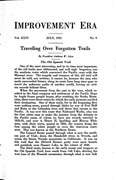
[p. 771]
The Old Spanish Trail
One of the most interesting, and in its time most important, of the old trails, now obliterated, and well nigh forgotten, was the southern route which connected the Pacific coast with the Missouri river. The tragedy and romance of this old trail will never be told, nor written; it cannot be, because the men who made unrecorded history along its route have long since gone to travel the unknown paths of another world, leaving no written records behind them.
When the movement from the east to the west, which resulted in the final conquest and settlement of the Pacific Slope by Anglo Saxon people began, after reaching the Rocky Mountains, there were three routes by which the early pioneers reached their destination. One of these trails, for in the beginning they were nothing more, passed through Idaho by way of Fort Hall and Boise to the Columbia river and down that stream to the Pacific. It was over this route that Nathaniel Wythe, who was the first white man to make the journey from the Atlantic to the Pacific coast, of whom, we have any record, traveled in 1832-33, and over it Henry H. Spalding and Marcus Whitman, with their wives, passed in 1836, the women being the first among the white people to cross the American continent. This was known as the Northern Route.
The Central Route passed through what is now the northern part of Utah, down the Humboldt river, in Nevada, and across the Sierra Nevada mountains to California. It was on this trail that the ill-fated Donner party were snow bound, and perished, near Donner Lake, in the winter of 1846.
The third route, known to the early scouts and trappers as the Old Spanish Trail, bore south from Salt Lake, skirting the west base of the Wasatch mountains, through what is now Salt
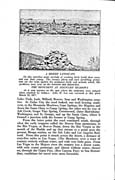
[p. 772]
A DESERT LANDSCAPE
On this waterless waste myriads of mocking birds build their nests, and rear their young. The century plants and cacti furnishing protection for the nests against the predatory birds and amimals which, like predatory men, prey on the innocent and defenseless.
THE MONUMENT AT MOUNTAIN MEADOWS
As it now appears on the spot where the emigrants were camped when attacked by Indians. John D. Lee was executed at this point March 23, 1877.
Lake, Utah, Juab, Millard, Beaver, Iron and Washington counties. At Cedar City the road forked, one trail bearing south-west, to the Mountain Meadows, Cane Springs, the Magotsu and down the Santa Clara to Camp Spring; the other was by way of Ash Creek, Grape Vine Spring, Cottonwood, (later Harrisburg) Washington and St. George, and up the Santa Clara, where it formed a junction with the former at Camp Spring. From the latter point the road continued south, through what the early trappers called the Beaver Dam mountains, to the Rio Virgen, at Beaver Dams, down the Rio Virgen to the mouth of the Muddy and up that stream to a point near the present Moapa station, on the Salt Lake and Los Angeles Rail-road. From this point it struck across the desert, a distance of sixty-five miles to Las Vegas, (The Meadows) over a tract of country entirely without water, and with very little grass. From Las Vegas to the Mojave river the country was a desert waste, with only scanty pasturage, and almost without water; thence on, through the Cajon Pass, (Box Canyon Pass) to San Bernardino, conditions for travel were more favorable.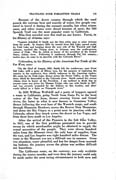
[p. 773]
Because of the desert country through which the road passed, the extreme heat and scarcity of water, few people ventured to travel it during the summer months, but when winter came, and other routes were closed because of snow, the Old Spanish Trail was the most popular route to California.
Who first traveled over this trail no one knows. Farris, in his History of Arizona, says:
"Captain Jedediah S. Smith was the first white man to enter Arizona from the north. In August, 1826, he started from Salt Lake, passed south, by Utah Lake and keeping down the west side of the Wasatch and high plateaus, reached the Virgen river, in Arizona, near the south-western corner of Utah. This he called, in honor of the president of the United States, Adams river. Following it southwest, through Pai Ute country, twelve days, he came to its junction with the Colorado River."
Crittenden, in his History of the American Fur Trade of the Far West, says:
"On the 22nd of August, 1826, Smith left the rendezvous, near Great Salt Lake, with a party of fifteen men, for the purpose of exploring the country to the southwest, then wholly unknown to the American traders. His route lay by Utah Lake, thence across the Sevier Valley, to the Virgin river, which he descended to the Colorado river. Smith named this stream Adams river in honor of the President. I am inclined to think that its present name was given for Thomas Virgin, who was with Smith in 1827, and was severely wounded by the Indians in this locality, and afterwards killed in a fight on Umpquah river."
In 1830 William Wolfskill and a party of trappers opened a route to California, going North from Santa Fe, to the head waters of the San Juan, thence crossing Green and Grand rivers, the latter in what is now known as Gunnison Valley, thence following the west base of the Wasatch range, and south through Mountain Meadows, across the Beaver Dam Mountains, and down the Rio Virgen to a point near its junction with the Colorado, where they struck across the desert to Las Vegas, and from there bore south to Los Angeles.
After the arrival of the Pioneers in the Salt Lake Valley, in 1847, one of the first problems presented was to provide means by which merchandise might be obtained to supply the actual necessities of the people. They were eleven hundred miles from the Missouri river, the only base of supplies, from the east, and Los Angeles was eight hundred miles distant. The route to the Missouri was not a difficult one in summer. Grass was abundant, water plentiful, and but for danger from marauding Indians; the journey across the plains was neither difficult nor hazardous.
The California route, on the contrary, was only available during the winter months, and even then the journey could only be made under the most trying circumstances to both men and
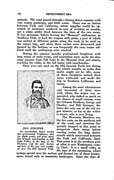
[p. 774]
animals. The road passed through a barren desert country, with very scanty pasturage, and little water. There was no station between Utah and California, where supplies could be obtained, or assistance rendered in case of accident or trouble, not a white settler lived between the lines of the two states. It was necessary, before leaving the "Mormon" settlements, in Southern Utah, to load the wagons with grain, a part of which was cached at different points along the road, to be used on the return trip, and when these caches were discovered and opened by the Indians, as was frequently the case, teams suffered until the settlements were reached.
During the summer months professional freighters, with long trains of mule teams, and sometimes oxen, made the tiresome journey from Salt Lake to the Missouri river and return, reaching the valley in the fall laden with merchandise.
Oxen were not used on the Old Spanish Trail, but during the winter months, in order that mules might not be idle, many of these freighters turned their faces westward, and made the trip to Southern California and return.
Among the most adventurous and successful of these men, with whom the writer was acquainted, who staked so much on the chance of small returns, were the Crismon Brothers, George and Charley, and Bill Streeper, the latter the only one of the old wagon masters, so far as the writer is aware, who is now living.
The Mountain Meadows was the last oasis, on the northern end of the road, and travelers frequently stopped at that point to recuperate their teams before starting across the long desert stretch which intervened between the Utah and California lines. This point is in the northern part of what is now Washington county, Utah. It is a small valley in the tops of the mountains, where springs spread over the surface and formed one of those beauty spots, found only in mountain landscapes. Since the days of
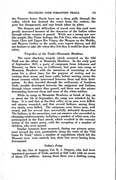
[p. 775]
the Pioneers heavy floods have cut a deep gully through the valley, which has drained the water from the surface, the grass has disappeared, and sage brush taken its place.
The dangers and difficulties of travel over this road were greatly increased because of the character of the Indian tribes through whose country it passed. While not a strong nor warlike people, like Plains Indians, the Pah Utes, who occupied the Santa Clara and Upper Rio Virgen, the Moapas on the Muddy, and Mojaves farther to the south, were expert thieves, and did not hesitate to take life when they felt that it could be done with safety.
Tragedies of the Trail—Mountain Meadows
The most shocking tragedy which occurred on the Old Trail was the affair at Mountain Meadows. In the early part of September, 1857, a party of emigrants from Arkansas and Missouri, on their way to California, had gone into camp at Mountain Meadows with the intention of remaining at that point for a short time, for the purpose of resting and recruiting their teams and loose cattle, before starting across the desert country which intervened between them and their destination. As they traveled through the settlements of Southern Utah, trouble developed between the emigrants and Indians, through whose country they passed, and there was also misunderstanding between them and some of the white settlers.
While in camp at Mountain Meadows, at break of day, on or about the 7th of September, the camp was attacked by Indians. It is said that at the first volley seven men were killed, and sixteen wounded, and that several Indians, among them two chiefs, were killed. The emigrants were brave men, well armed, and for several days successfully defended themselves. The Indians, in the meantime, sent out runners who succeeded in obtaining reinforcements, including, a number of white men, who participated in the final attack, which resulted in the extermination of the entire party, with the exception of a number of children, who were spared.
Similar instances have occurred, during our pioneer movement toward the west, particularly along the route of the "Old Santa Fe Trail," where a number of expeditions which left the Missouri river were entirely lost, their fate never having been determined.